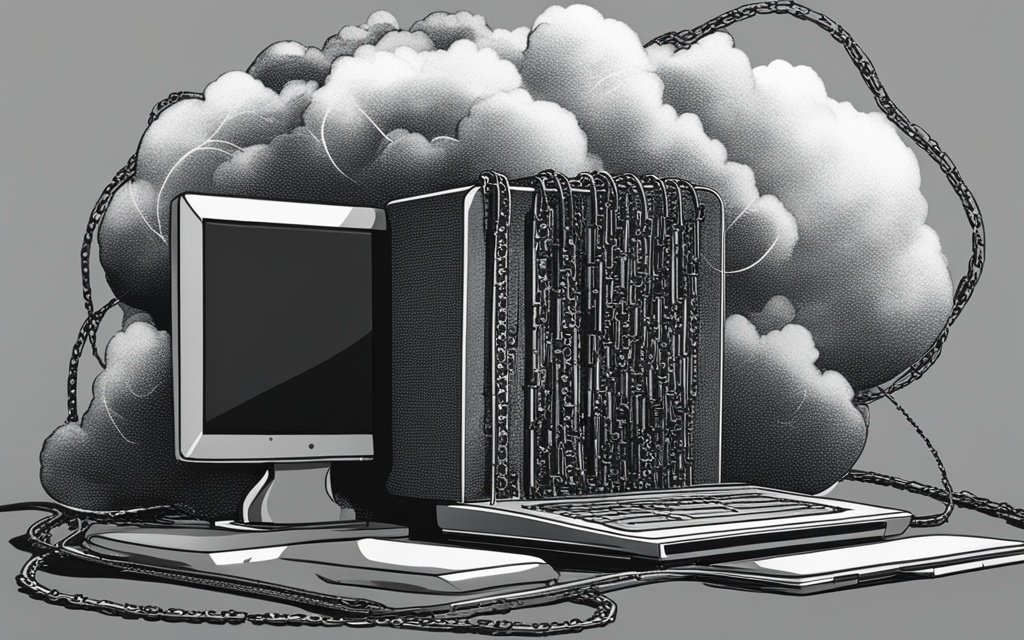Cloud computing has become very popular, offering many benefits like flexibility, scalability, and saving money. But, there are wrong ideas about it. We will clear up these myths and give true facts to help you decide if cloud computing is right for you.
Key Takeaways
- About 70% of businesses think cloud computing is less secure, but big cloud companies spend a lot on keeping data safe1.
- Cloud computing is not always expensive. In fact, it can save businesses up to 40% compared to old ways of doing things1.
- With cloud computing, you only pay for what you use. This means you can easily change how much you use and pay based on your needs1.
- Cloud computing lets companies be flexible. You can change services and resources to fit what you need1.
- Cloud computing offers different services and models. These give you various levels of control, security, performance, and cost1.
- Moving to the cloud doesn’t mean you lose control. Cloud services give you tools to manage and change things as you like2.
- Cloud-hosted apps can be as fast or even faster than those on your own servers. This is thanks to better networking and Content Delivery Networks (CDN)2.
Myth #1: The main value of cloud business cases is IT cost reductions
Many think the main benefit of cloud computing is saving money. But, it’s more than that. Cloud computing changes how IT works and brings many business benefits.
In 2019, the actual statistic for enterprise workloads in the cloud was at 9%, which was half the forecasted rate of over 16%3.
Cloud computing helps businesses use advanced analytics. This speeds up decision-making and supports data-driven strategies. It gives companies insights, trends, and the power to make smart choices for growth.
It also makes it quicker to bring products and services to market. With the cloud’s scalability, companies can quickly develop and test new apps and services. This lets them quickly respond to market changes and beat competitors.
Cloud computing encourages innovation by offering a wide range of tools and platforms. Companies can use these to boost their research, try out new tech, and create groundbreaking solutions.
It also opens up new ways to make money. Businesses can try new models, enter new markets, and find new income sources. Cloud computing helps them grow efficiently, reach more people, and offer unique services.
Larger companies typically spend about 0.5% of their total revenues on application hosting3.
While saving on IT costs is key, it’s not the only benefit. Cloud computing’s real value is in transforming businesses and unlocking their full potential.
Myth #2: Cloud computing costs more than in-house computing
Many think cloud computing is pricier than keeping things in-house. But, the truth is more complex. The cost difference between cloud and in-house computing depends on many things.
Costs change based on an organization’s current IT setup and its level of maturity. Also, the type of licenses and workloads matter a lot. (Reference: Statistical data4)
Cloud computing uses shared resources and can scale up or down as needed. This can lead to cost savings. But, it’s key to manage resources well to see these savings. (Reference: Statistical data4)
Cloud computing might need an initial investment and costs for moving data. But, it should lead to lower costs over time. It’s vital to look at both the upfront and ongoing costs. Cloud services offer a pay-as-you-go option, which can be a big plus for businesses. (Reference: Statistical data4)
In-house computing has its own costs too. Running and maintaining servers needs IT support, which costs money. These costs should be compared with cloud computing costs. (Reference: Statistical data5)
Cloud providers may limit how long data can be kept, so extra backups are needed. This adds to the cost for businesses using the cloud for storing data. (Reference: Statistical data5)
Security risks are not unique to the cloud or in-house setups. Big breaches have happened in both, showing that security issues often come from weak passwords and system flaws, not where the data is stored. (Reference: Statistical data5)
Choosing cloud computing should be based on a detailed look at what your business needs, costs, and the cloud provider’s security. This way, businesses can pick the best tech solution for them. (Reference: Statistical data5)
Myth #3: The security I can set up and control in my own data centers is superior to the security on cloud
Many think they can get better security by controlling their own data centers. But, this overlooks the big steps forward in cloud security. Cloud providers work hard to keep their data safe.
Cloud security has grown a lot, with big cloud providers using the latest security tech and skilled teams. This means they can offer strong security that might be better than what one company can do alone.
Some cloud breaches come from how customers set things up, not from the cloud itself. It’s up to companies to use secure practices and adapt to the cloud with a secure way of working.
Bring Your Own Key (BYOK) might seem like a boost to cloud security. But, stats6 show it doesn’t always help as much as thought. Instead, Multi-Factor Authentication (MFA) is seen as a better way to keep accounts safe by adding an extra check.
Stats6 also show BYOK isn’t the magic solution some think it is. The cloud provider still has a key copy. It’s key to know that while encryption is important, it can’t fix all security problems on its own.
To make the cloud safer, companies should focus on more than just BYOK. They should pick their cloud region wisely and make sure the provider has strong security in place. This helps protect against different kinds of threats.
Seeing cloud security as a team effort is important. Cloud providers spend a lot on keeping their data centers safe and improving their security. Big names like Microsoft, Amazon, and Google lead in making the cloud safer.
Using private line direct connectivity can also add an extra layer of security. It helps keep sensitive data safe by limiting who can access applications and services in the cloud.
Cloud vs On-Premises Security Comparative Analysis
| Security Aspect | Cloud Security | On-Premises Security |
|---|---|---|
| Investment in Security | Cloud providers invest heavily in securing their data centers and enhancing security measures. | Organizations must allocate significant resources to establish and maintain their own security infrastructure. |
| Expertise | Cloud providers have dedicated teams of cybersecurity experts. | Organizations must hire and retain cybersecurity talent to ensure effective security. |
| Scalability | Cloud security scales easily to meet the evolving security needs of organizations. | Organizations need to invest in additional security infrastructure as their needs grow. |
| Cost | Cloud security offers cost-efficiency by eliminating the need for extensive investments in security hardware and personnel. | Organizations bear the costs of establishing, maintaining, and upgrading their own security infrastructure. |
| Shared Responsibility | Cloud security is a shared responsibility between the cloud service provider and the organization. | Organizations have full control and responsibility for security in their own data centers. |
Companies worried about data privacy and security in the cloud should look at the stats7. They show over 80% of healthcare groups are hesitant to move to the cloud. But, cloud partners with deep knowledge in security can help by using strong security steps and meeting compliance needs.
The healthcare sector is concerned about data breaches and cybersecurity. But, stats7 reveal about 25% of healthcare groups plan to move most apps to the cloud soon. This shows a chance for big changes and the benefits of cloud security.
This article goes deeper into cloud security myths, clearing up wrong ideas and showing the good parts of cloud security. Also,this Medium post talks about the truth behind cloud fears and clears up myths. Plus,this LinkedIn post talks about how cloud computing is actually safer than old on-premises setups.
Myth #4: There is greater latency among applications running on cloud providers’ networks than there is on in-house networks
Some think cloud networks have more latency than in-house ones. But, this isn’t quite right. Cloud computing uses top-notch networking tech and infrastructure. This can often match or beat in-house network speeds.
Cloud providers spend billions on security and have thousands of cybersecurity experts8. They have strong infrastructure and use Content Delivery Networks (CDNs). This means apps run smoothly and fast, cutting down on cloud latency.
Cloud networks usually have very little latency, even for workloads across many regions9. Providers set up their data centers for low latency, focusing on being always available and reliable9. CDNs also help by bringing users closer to the cloud, making things faster9.
Some try to send their network traffic back to their own data centers for security. But, they often miss out on CSPs’ strong security options. These options, along with cloud content delivery, can be faster than in-house networks8. Moving to the cloud doesn’t mean slower performance, especially with CSPs’ help.
Clouds also make following rules easier for companies. Most cloud providers meet many rules like PCI DSS, HIPAA, and GDPR9. For example, Microsoft Azure has over 90 compliance options to help meet these rules10.
Switching to the cloud shouldn’t scare you because of latency worries. With good planning, companies can save money and get better cloud performance. Gartner says public cloud spending will jump to 45% of all IT spending in five years10. It’s important to understand that cloud latency isn’t a big issue. Cloud providers and CDNs offer fast and reliable app performance.
Myth #5: Cloud computing is not secure
Many think cloud computing isn’t secure, but this belief is wrong. Cloud providers work hard to keep data and systems safe. They use top-notch technologies and methods for the best cloud security.
Keeping data safe is crucial for cloud providers. They use strong encryption to protect data at rest and in transit. This means even if someone gets into the data, they can’t read it.
Cloud providers also use strong checks to make sure only the right people get in. This stops unauthorized users from seeing sensitive data or changing things they shouldn’t. With strong checks like multi-factor authentication, cloud security gets even better.
Firewalls are key to keeping out unwanted network access. They watch the traffic going in and out, blocking any bad stuff. This makes it much harder for hackers to get in and reduces the chance of cloud breaches.
Cloud providers are great at backing up data. They keep copies of data on several servers. This means if one server goes down, the data is still safe. This makes losing data much less likely and keeps cloud data safe.
Cloud computing also has advanced security tools and checks. These let businesses keep an eye on what’s happening in the cloud. This helps spot and stop security issues early. With these tools, companies can act fast to stop breaches.
Cloud security is often better than what companies can do on their own. Cloud providers spend a lot on keeping their systems and data safe. They focus on physical security, network security, encrypting data, and more. This means customers’ data is well-protected.
Even with all the security, mistakes by users can still lead to breaches. Things like weak passwords or wrong settings can be a problem. But, cloud providers make it easy to use and help businesses follow best practices.
Cloud computing is a great choice for companies watching their budget. It’s cheaper and offers more for less. Companies can pick how much control they want over their stuff. Cloud providers also give tools and APIs to help manage things automatically.
In conclusion, the idea that cloud computing isn’t secure is wrong. Cloud providers really focus on keeping data and systems safe. With all the tech and steps they take, cloud computing is a safe choice. Companies can trust that their data is secure and well-protected in the cloud.
Myth #6: Cloud computing is one size fits all
Cloud computing is not a one size fits all solution. It has various cloud service types and models. These can be tailored to meet the unique needs and goals of businesses.
Businesses can pick from Software as a Service (SaaS), Platform as a Service (PaaS), and Infrastructure as a Service (IaaS)11. Each type offers different levels of functionality and control. This lets organizations choose the best fit for their needs.
Cloud computing also comes in public, private, and hybrid models12. Public clouds are open to many organizations and offer scalability and cost savings. Private clouds are for one organization only, giving better security and control. Hybrid clouds mix the perks of public and private clouds, letting businesses use the best of both.
This flexibility in cloud computing lets businesses tailor their solutions to their specific needs and likes. It ensures they can pick the most suitable options for their applications and workloads.
Also, businesses can choose where to host their applications and data12. They can pick from public clouds, private clouds, or on-premise. This depends on things like security needs, compliance rules, and workload demands.
Customizing cloud solutions is key for the best performance and cost-efficiency. By picking the right cloud services and models, businesses can use cloud computing to their advantage. This aligns with their unique needs and goals.
Key Takeaways:
- Cloud computing is not a one size fits all solution.
- Businesses can choose from different cloud service types such as SaaS, PaaS, and IaaS.
- Cloud computing offers public, private, and hybrid cloud models.
- Customization allows for multiple deployment options across public clouds, private clouds, or on-premise.
Myth #7: Cloud computing is expensive
Many think cloud computing is pricey, needing big upfront costs and ongoing upkeep. But, it’s actually quite cost-effective and can lead to big cloud cost savings.
Cloud computing cuts costs in several ways. It means no need to buy and keep servers, hardware, and update software. This saves a lot of money upfront for businesses.
It also needs fewer people to look after it, saving more money. This is because cloud computing is easier to manage than old-style computing setups.
Also, cloud computing doesn’t cost money for software updates. Cloud providers take care of these updates, saving businesses more cash.
Cloud computing costs vs. traditional computing costs
| Cloud Computing | Traditional Computing |
|---|---|
| Eliminates upfront infrastructure investments | Requires purchasing and maintaining physical infrastructure |
| Reduces staffing needs | Requires a larger IT team for maintenance |
| No expenses for software upgrades | Incurs costs for software updates and maintenance |
Using the cloud lets businesses use computing resources as they need them. This pay-as-you-go model means paying only for what’s used, leading to more cloud cost savings.
Cloud computing also lets businesses use the expertise of cloud providers. These providers offer affordable cloud solutions because they specialize and spread costs over many customers.
Plus, the cloud helps businesses manage their money better. Moving to the cloud means less upfront costs for infrastructure, improving cash flow and financial flexibility.
But, it’s key to remember that cloud computing isn’t always cheap. A survey by Andot found 50% of companies struggle with cloud costs due to issues like wasted resources, poor cloud setup, and lack of visibility into cloud workloads13.
In conclusion, the idea that cloud computing is too expensive is a myth. In truth, it can bring big cloud cost savings and be a cost-effective cloud solution. It cuts the need for big upfront investments and ongoing upkeep costs of traditional computing.
Conclusion
Cloud computing myths have been debunked, showing its true value. It brings many benefits that can change how businesses work. By clearing up false beliefs, we see its real worth and what it can do.
Many thought cloud computing was too expensive. But facts14 show that losing service can cost a business $100,000 an hour. Cloud computing can save money and improve how apps work and keep data safe.
Some worried about losing control over their IT setup. But, using a mix of cloud services15 can fix this. This way, businesses avoid service outages and get good deals.
Cloud computing means security must be a top priority14. Companies need to keep their teams up to date on security to fight off threats. Knowing about cloud types and how they work helps businesses make smart choices. They can use features like easy setup and strong data protection15.
In the end, cloud computing helps businesses be more agile, grow, and innovate. By clearing up wrong ideas and seeing cloud computing for what it is, companies can use its full power. This moves them forward in the tech world.
FAQ
What is the main value of cloud computing?
Cloud computing boosts analytics and speeds up getting products to market. It also fuels innovation and helps grow revenue. It’s not just about cutting IT costs. It’s about changing how IT works and boosting the business overall.
Is cloud computing more expensive than in-house computing?
The cost of cloud computing varies. It depends on where you start, how mature your IT is, your license deals, and the types of workloads. Cloud can be cheaper thanks to its shared model and ability to scale. But, you need to manage resources well to make the most of it.
Is on-premises data centers more secure than the cloud?
Big cloud providers put a lot into security and have great cybersecurity teams. Most cloud breaches happen because of user mistakes. If you use a secure DevSecOps model, the cloud can be safer than keeping data on-premises.
Do applications running on cloud providers’ networks experience higher latency?
Cloud apps can be as quick or quicker than those on your own networks. This is thanks to advanced tech and Content Delivery Networks (CDNs). Cloud providers make sure their networks are set up for fast data transfer, ensuring apps work well and reliably.
Is cloud computing secure?
Yes, cloud providers focus a lot on security. They use encryption, authentication, firewalls, backups, and audits. Even if users make mistakes, cloud providers have top security, making it a safe choice.
Is cloud computing a one size fits all solution?
Cloud computing comes in many services and models like SaaS, PaaS, and IaaS. You can choose between public, private, or hybrid clouds. This lets businesses tailor their cloud use to their needs, offering different levels of control and scalability.
Is cloud computing expensive?
Cloud migration might cost upfront, but it can save money over time. It cuts the need for buying and keeping up physical gear and uses a pay-as-you-go model. For small and medium businesses, it’s a cost-effective way to grow without big IT costs.
What are the benefits of cloud computing?
Cloud computing brings cost savings, better security, fast app performance, flexibility, and cost savings. It helps businesses be more agile, scalable, and innovative.
Why should I choose cloud computing?
Cloud computing offers flexibility, scalability, and cost savings. It improves analytics, speeds up getting products out, boosts innovation, and grows revenue. It also means no need for physical gear and strong security. Using cloud helps businesses be more agile and innovative.
Source Links
- https://www.linkedin.com/advice/3/what-some-common-cloud-computing-myths-misconceptions – What are some of the common cloud computing myths and misconceptions that you encounter?
- https://nerdssupport.com/9-common-misconceptions-cloud/ – Exposing the Truth: Debunking Common Cloud-Computing Myths | Blog
- https://dtinetworks.com/common-myths-about-the-cloud-debunked/ – The Cloud: Debunking Common Myths | DataGroup Technologies
- https://www.cloudcomputing-news.net/news/2022/mar/28/three-myths-about-cloud-costs-debunked/ – Three myths about cloud costs debunked
- https://www.corsicatech.com/blog/4-common-cloud-computing-myths-busted/ – 4 Common Cloud Computing Myths BUSTED
- https://www.keepit.com/blog/what-you-should-know-about-byok/ – The truth about BYOK and 3 myths in the security industry | Keepit
- https://www.linkedin.com/pulse/cloud-computing-does-mean-degraded-security-fact-safer-chris-woolsey – Cloud computing does not mean degraded security; in fact, the cloud is safer for storing data when you work with the right partner.
- https://dihubcloud.eu/wp-content/uploads/2021/12/7-Cloud-Myths.pdf – #7 Cloud Myths
- https://www.dataversity.net/debunking-cloud-and-cloud-migration-myths/ – Debunking Cloud and Cloud Migration Myths – DATAVERSITY
- https://www.cloudficient.com/blog/7-myths-about-the-cloud – 7 Myths About the Cloud
- https://www.gbtech.net/7-cloud-computing-myths-debunked/ – 7 cloud computing myths debunked
- https://www.forbes.com/sites/oracle/2013/06/11/the-top-10-myths-about-cloud-computing/ – Oracle BrandVoice: The Top 10 Myths About Cloud Computing
- https://svitla.com/blog/cloud-computing-myths – 7 Cloud Computing Myths Dispelled | Svitla Systems
- https://cloudacademy.com/blog/disadvantages-of-cloud-computing/ – Disadvantages of Cloud Computing
- https://www.techtarget.com/searchcloudcomputing/definition/cloud-computing – What is Cloud Computing? Types, Examples and Benefits | TechTarget


















